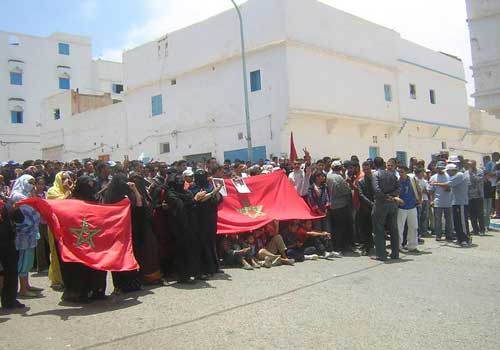Links 12/25/2025
3 hours ago







It was the morning of Saturday June 7th, Maryam got out from her home for shopping. A policeman in the street insults her: "hoe, bitch!" She asks the policeman to moderate his language. Another agent then brings her to the police chief. He commands: "bring her where she gets fucked!" They bring her to the wall of the secondary school Mulay Ben Abdellah. There she watches 15 policemen brutally beating a young man. Then it comes her turn.
A policeman with his face covered beats her buttocks. When she stops yelling because she doesn't even feel the pain anymore, he beats her on the face and body. When she tries to cover her face another agent grabs her so his mate could continue the beating, that continues till she faints. Then a police car brings her to the police station.
At the gate she's brought out of the car through more beatings, they even threaten with breaking her galsses (Maryam is myopic). She cries that she had to sell a sheep to buy them. A policeman keeps her glasses and she's brought into the building.
Once inside humilliations begin: mockery and more mockery, they take off her clothes, they touch every corner of her body. Each time she tries to resist they beat her brutally. A policeman puts his baton between her legs. Up to 10 policemen abuse her sexually. In other rooms groups of women are forced to undress before the policemen with tehir husbands as witnesses. Many women that have gone through the police station have been abused that way, knowing the policemen that most won't say anything because of what implies in their society. In another room young men are forced to sit on bottles. The "good cop" finally appears and ask fogiveness for what they are doing to her.
A chief walks around the naked men and women. A young man asks to talk with the Caid of Agadir, claiming that he had arrived to Sidi Ifni to fullfill a mandate from the Caid and that is car is outside to prove it. The chief, arrogant, says: "We follow orders of King Mohammed VI. Is maybe your Caid more than the King himself?" Maryam remembers perfectly the face of who said that and claims that she would recognize him among thousands.
A policeman throws her to the floor, grabbing her neck with his legs. "If you move, I'll kill you". More beatings, abuses and humilliations.
They put a bandage on her eyes and bring her upstairs to interrogate her. For the first time she's not beaten. They take her data. They ask for her people, if she belongs to any organization, what ideas does she have, what does she think of the situation in Sidi Ifni. Then they bring her downstairs, take off the bandage and set her free.
At the exit a group of policemen surround her, insult her, beat her again. One yells: "The dick of the Makhzen is very long, bitch!" Never in her life Maryam heard so many insults nor so nasty ones.
June 7th will be recorded for long in the memory of the people of Sidi Ifni because of the savage behaviour of the Moroccan polcie forces commanded by General Laanigri, element that secures the continuity of the regime of Hassan II into that of Mohamed VI.





Statement 1: We believe that there is no scientific basis for any claim that the pattern of human genetic variation supports hierarchically organized categories of race and ethnicity
Statement 2: We recognize that individuals of two different geographically defined human populations are more likely to differ at any given site in the genome than are two individuals of the same geographically defined population
Statement 3: We urge those who use genetic information to reconstruct an individual's geographic ancestry to present results within the broader context of an individual's overall ancestry
Statement 4: We recognize that racial and ethnic categories are created and maintained within sociopolitical contexts and have shifted in meaning over time
Statement 5: We caution against making the naive leap to a genetic explanation for group differences in complex traits, especially for human behavioral traits such as IQ scores, tendency towards violence, and degree of athleticism
Statement 6: We encourage all researchers who use racial or ethnic categories to describe how individual samples are assigned category labels, to explain why samples with such labels were included in the study, and to state whether the racial or ethnic categories are research variables
Statement 7: We discourage the use of race as a proxy for biological similarity and support efforts to minimize the use of the categories of race and ethnicity in clinical medicine, maintaining focus on the individual rather than the group
Statement 8: We encourage the funding of interdisciplinary study of human genetic variation that includes a broad range of experts in the social sciences, humanities and natural sciences
Statement 9: We urge researchers, those working in media, and others engaged in the translation of research results to collaborate on efforts to avoid overstatement of the contribution of genetic variation to phenotypic variation
Statement 10: We recommend that the teaching of genetics include historical and social scientific information on past uses of science to promote racism as well as the potential impact of future policies; we encourage increased funding for the development of such teaching materials and programs for secondary and undergraduate education
What is evidenced and scares is the consideration that have in our country the violations of fundamental rights: a minor crime destined to prescription in tribunals, totally irrelevant for politicians, that in all these years have been unable to pass a law against torture and fire the public servants (in some cases they have even been promoted!) involved in the processes for the Genoa G8 meeting. In Bolzanetto [the jail near Genoa] unacceptable abuses were comitted. Mistreatment to detainees is totally incompatible with democracy. In these years a climate of impunity has been promoted. We ask to the political forces and the Parliament: is Italy still a democracy?









